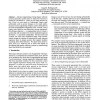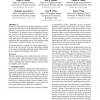677 search results - page 3 / 136 » Reverse Engineering Super-Repositories |
ICSE
1995
IEEE-ACM
13 years 11 months ago
1995
IEEE-ACM
— Reverse engineering of large legacy software systems generally cannot meet its objectives because it cannot be cost-effective. There are two main reasons for this. First, it is...
ICSE
2000
IEEE-ACM
13 years 11 months ago
2000
IEEE-ACM
By the early 1990s the need for reengineering legacy systems was already acute, but recently the demand has increased significantly with the shift toward web-based user interfaces...
WCRE
1999
IEEE
13 years 12 months ago
1999
IEEE
As a program evolves, it becomes increasingly difficult to understand and reason about changes in the source code. Eventually, if enough changes are made, reverse engineering and ...
INFSOF
2007
13 years 7 months ago
2007
An infrastructure is a set of interconnected structural elements, such as tools and schemas, that provide a framework for supporting an entire structure. The reverse engineering c...
OOPSLA
2000
Springer
13 years 11 months ago
2000
Springer
Reverse engineering is the process of uncovering the design and the design rationale from a functioning software system. Reverse engineering is an integral part of any successful ...


